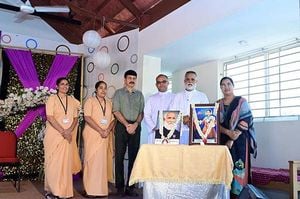India's emergence as a significant player in artificial intelligence is not just about technological advancement; it's about cultural relevance and societal impact. Over the past year, the nation has seen remarkable strides, aligning its investments and innovations closely with local language nuances and business needs.
With the support of government initiatives for homegrown AI startups, 2024 has marked the launch of several groundbreaking AI models. These models are making waves not just nationally but also setting benchmarks for global AI ecosystems. This piece delves deep, exploring the most impactful Indian AI models developed this year and their contributions to the growing field of artificial intelligence.
One standout project is BharatGen, the first government-funded initiative aimed at developing multimodal large language models (LLMs). The initiative launched e-vikrAI, which uses advanced Vision Language Models geared toward the Indian e-commerce market. This tool allows sellers to simply upload product images to receive auto-generated titles and descriptions aligned with the cultural essence, thereby easing the hassle of manual inputs.
On the corporate side, NVIDIA's CEO Jensen Huang introduced the Nemotron-4-Mini-Hindi-4B during his visit to India. This innovative Hindi language model, derived from NVIDIA's multilingual foundation models, promises immense potential for businesses focusing on the regional demands of the Indian market. Tech Mahindra is the first company taking advantage of this model, creating Indus 2.0, which emphasizes Hindi and its dialects.
This Hindi model features 4 billion parameters and has proven its worth by outshining many larger models on accuracy benchmarks. It showcases how artificial intelligence can be optimized for local languages and practical applications, incredibly important for sectors like education and healthcare.
Meanwhile, Bhavish Aggarwal's Ola launched Krutrim, which has caught attention for its capability to understand 22 Indian languages and generate text across ten languages, including regional favorites. Training conducted on over 2 trillion tokens ensures it resonates with the distinct cultural flavors of India.
Another significant player is Sarvam AI, which introduced Sarvam-1, developed to be the first LLM optimized for major Indian languages. Featured with 2 billion parameters, this model touts remarkable computational efficiency, providing four to six times faster inference speeds compared to larger models, making it suitable for numerous deployment scenarios, particularly on edge devices.
Surya OCR made headlines with its successful launch of version 2, claiming superiority over existing solutions like Tesseract. It provides reliable optical character recognition for various formats and includes features like layout detection and command-line access, streamlining the document processing experience.
SML’s latest offering, Everest 1.0, aims to set itself apart with multilingual support covering Hindi, Bengali, Tamil, and Telugu. Designed for real-time data access and predictive insights, Everest is built on cutting-edge architecture, emphasizing inclusivity across many sectors.
Beyond traditional tech applications, the open-source platform Chitralekha, developed by AI4Bharat, focuses on video transcreation. This platform empowers users to auto-generate transcripts and facilitate video translations across diverse Indic languages, demonstrating the intersection of AI with media and communications.
AI4Bharat also unveiled Airavata, attuned for Hindi, underscoring efforts to refine training methodologies for AI models. This model improves task responses through human-curated datasets, illustrating how cultural factors are integrated within technical frameworks.
On the startup front, Two AI's SUTRA has introduced models aimed at efficient, multilingual processing across 50 languages, employing dual-transformer architectures. This innovative approach shows promise for diverse language applications, particularly useful for India's varied linguistic palette.
Further enriching these developments, Devika, created by 21-year-old Mufeed VH, emerges as an open-source AI assistant capable of executing complex coding instructions, utilizing prominent AI frameworks, and addressing both creative and technical needs.
The impact of these innovations extends beyond tech circles. During the ISB Insights Forum 2024, Union Minister for Education Shri Dharmendra Pradhan underscored the importance of integrating AI within educational frameworks. He emphasized the need for research-driven solutions and highlighted technology's potential to bridge linguistic gaps across communities. By facilitating seamless communication, AI can significantly reshape the educational sector and other industries.
Various speakers at the event echoed similar sentiments, reinforcing AI's role as a transformative technology. The discussions outlined future goals, including the cultivation of entrepreneurial talent and fostering deep-tech development to bolster India's standing as an AI hub.
The acquisition of Vedvaani by BrahmVeda Ventures exemplifies this drive. By blending traditional astrological insights with modern AI technology, the app aims to provide personalized predictions and enrich user engagement, showcasing the versatility of AI applications across diverse sectors.
The current evolution of AI isn't just about creating impressive models; it's about fostering meaningful interactions and connections among people. By leveraging local languages, cultural integrity, and innovative tech, India's advancements signify more than just growth—they represent the country’s commitment to making AI accessible and beneficial for all.
With promising models and initiatives like BharatGen, the future looks bright for AI innovation rooted firmly within its cultural and linguistic contexts. These developments signify India's growing influence on the AI front, setting the stage for broader global engagement.
Looking back on this year's achievements, it's clear to see how the interplay between culture, technology, and innovation is redefining the AI narrative within India. The nation’s strides not only enrich its capabilities but also contribute significantly to the larger conversation about the ethical and inclusive application of AI technologies. Stay tuned as we continue witnessing exciting transformations influenced by these revolutionary frameworks.



